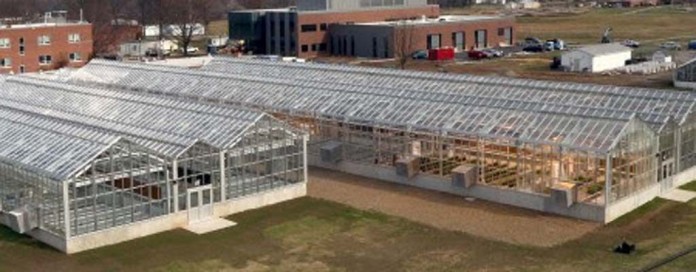WOOSTER, Ohio — The new Williams Hall greenhouse complex on the Ohio Agricultural Research and Development Center’s Wooster campus is much more than a replacement for the greenhouse lost to a tornado almost five years ago: It’s a state-of-the-art facility that will help advance plant research and strengthen Ohio agriculture.
The original Williams Hall greenhouse complex was leveled by a September 2010 tornado that destroyed or damaged many other buildings and more than 1,000 trees at OARDC, the research arm of The Ohio State University’s College of Food, Agricultural, and Environmental Sciences. The new greenhouses became operational in November 2014.
“It has been a long time coming, but our new facility will enhance the research and educational capabilities of our programs,” said Michelle Jones, professor and chair of the Department of Horticulture and Crop Science’s Greenhouse Committee. “It is a huge improvement from the greenhouses that previously occupied this site.”
More space
The new complex includes 14,400 square feet of space for conducting greenhouse research and growing plants for laboratory-based research projects — with more than 20,000 square feet of total space including the hallways. The facility is divided into 14 bays that are 24 feet by 40 feet each and two smaller bays, 24 feet by 20 feet each.
The greenhouses are controlled by an Argus Titan 2 environmental control system, which allows each researcher to independently control the environmental parameters for his or her experiments and plants.
Program needs
The Williams greenhouses serve programs in the Department of Horticulture and Crop Science and the School of Environment and Natural Resources. Programs assigned to this facility will be changing according to research needs, Jones said. Breeding programs and phenotyping projects that were previously housed in the Gourley Hall greenhouse complex may move to Williams because the individual greenhouse bays are larger.
“We didn’t want to exactly duplicate the capabilities of the other research greenhouses on the OARDC campus, but wanted to provide a versatile greenhouse with excellent environmental control that would meet the changing needs of our current and future research programs,” said Jones, the D.C. Kiplinger Floriculture Endowed Chair. “Some improved features, like the motorized ridge vents controlled by Argus, will allow for better temperature control in the summer months.”
Some of those needs include Jones’s own research. An expert on ornamental plants, Jones studies ways to improve flower crops and extend their life by making interventions at the molecular level.
“There are many features of the new greenhouse that have had a positive impact on our research,” Jones said. “Soil moisture probes connected to the Argus computer precisely control the amount and frequency of irrigation based on the water needs of the plants. This provides consistent, uniform soil moisture and results in more even plant growth. It is very important for us to avoid water stress when we are studying developmental senescence, or the age-related death of plant tissues.”
Right kind of greenhouse
To successfully conduct nationally and internationally recognized plant research, scientists need to be able to grow a crop consistently month after month and year after year. Having the right kind of greenhouse is critical to achieving such a goal, Jones said.
The facility also features individual fertilizer injectors in each greenhouse bay instead of a centralized system that would provide only a few fertilizer options to the entire complex.
“Since we grow such a diverse array of plants — from rubber dandelions and petunias to soybeans and wheat — it was almost impossible to identify a few fertilizers that could be used for all these crops,” Jones said. “Having fertilizer injectors in each room allows each researcher to optimize the fertility program for their crop and their experiments.”
OARDC Director Steve Slack said modern and functional infrastructure is crucial for conducting agbiosciences research that benefits industry, consumers and society at large.
“The new greenhouses are state-of-the-art facilities that will enable our world-class faculty to enhance the scope and depth of their scientific contributions on plant genetics, growth and nutrition and to bring these discoveries forward to application,” he said.










